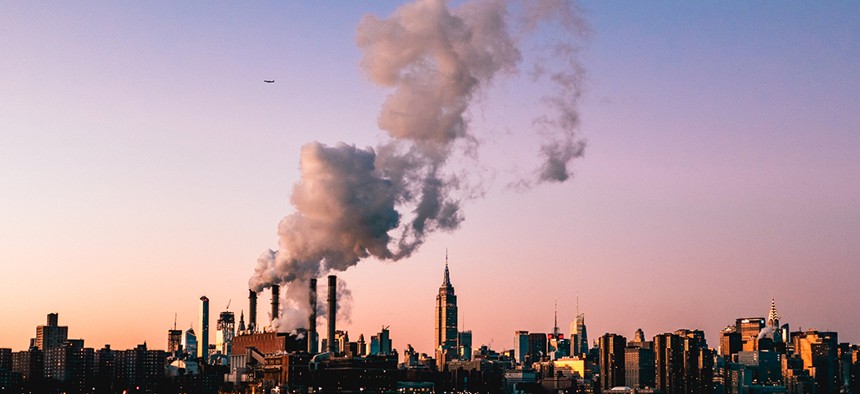Sustainability continues to be a hot topic in New York. Parts of the state are still rebuilding after the devastation of Superstorm Sandy, while at the same time taking preventive measures to increase resiliency in the face of warming oceans that could result in worsening storms and rising sea levels. However, the climate is a very broad topic that itself can be addressed from many different angles. Here are four key sustainability issues, climate change-related or otherwise, currently affecting the state.
Congestion pricing
Proposed as a way to fund New York City’s deteriorating subway system and reduce traffic on overcrowded city streets, enacting congestion pricing could also have a positive effect on the environment. When former Mayor Michael Bloomberg proposed congestion pricing in 2007, he did so with sustainability in mind, as part of a larger plan to create a greener city. At its core, congestion pricing is meant to encourage people to take more sustainable public transportation options like buses and subways over driving. According to the Federal Highway Administration, congestion pricing reduces fuel consumption and pollutants emitted by lowering the number of cars on the streets and in stop-and-go traffic. A study examining the effects of congestion pricing in Stockholm, where it was implemented more than a decade ago, found that greenhouse gas emissions from traffic had decreased by 2.7 percent. Assemblyman Steve Englebright said he views congestion pricing as first and foremost a tool to help the environment, with funding for the city subways as an added bonus, rather than a primary purpose.
Water quality
The quality of New York’s water continues to be an area of concern for many living in the state. In the fiscal year 2019 state budget, lawmakers continued funding the $2.5 billion Clean Water Infrastructure Act, which was passed last year as part of an effort to improve drinking water quality and water infrastructure. However, it may cost the state $40 billion to properly repair and upgrade aging water infrastructure and ensure people have clean, safe drinking water, according to a report that state Comptroller Thomas DiNapoli’s office released last year. In 2015, residents of Hoosick Falls, a village in Central New York, learned that their water contained the toxic chemical perfluorooctanoic acid, or PFOA, from a nearby manufacturing plant, and that the state had known about the contamination for months. Gubernatorial candidate Cynthia Nixon recently visited the village, where residents are still calling for a new water source, and railed against Gov. Andrew Cuomo’s response to the crisis. But the issue is not isolated to one part of the state. On Long Island, harmful algal blooms threaten every major bay or estuary and kill fish and turtles. It is also a problem in the Finger Lakes region. The state budget included $65 million to fight algal blooms in upstate lakes. Also on Long Island, a possible carcinogen was detected in low levels in much of the island’s drinking water last year.
Food waste
This year, the New York League of Conservation Voters named food waste as one of its top priorities, saying that 18 percent of New York’s solid waste stream is food waste. The state generates 3.9 billion tons of food waste every year, and only about 3 percent of that gets diverted from landfills, according to a 2017 report by the New York State Energy Research and Development Authority. For the past two years, Cuomo has proposed the Food Recovery and Recycling Act as part of his executive budgets, and both times, the bills did not make the final cut. They would have required commercial businesses, like restaurants and supermarkets, that generate at least two tons of food waste per week to donate leftover food and recycle scraps. For the past two legislative sessions, state Sen. Kevin Parker has also sponsored the state Food Waste Prevention and Diversion Act, which would require state-run facilities to divert excess food and food waste to donation and recycling programs. It has never made it out of committee and a companion bill has not been introduced in the Assembly. However, Assemblyman Steve Englebright, the chairman of the Committee on Environmental Conservation, told City & State that he expects food waste to be a key sustainability issue in November’s general elections. He also said the Assembly plans to introduce a stand-alone bill of Cuomo’s proposal.
Renewable energy
In 2016, Cuomo established the Clean Energy Standard that mandated 50 percent of the state’s electricity come from renewable sources by 2030 in order to help combat climate change. The state produces more than a quarter of its net electrical energy from renewable sources. In March, Cuomo announced a $1.4 billion investment in 26 large-scale renewable energy projects across the state to help reach that goal. His office said that was the largest single commitment ever made by a state to renewable energy. In the state Legislature, the Climate and Community Protection Act would require the New York Power Authority, the Long Island Power Authority and any entities regulated by the Public Service Commission to produce 50 percent of their power from renewable sources by 2030. It includes other provisions, such as the establishment of greenhouse gas reporting requirements and creating the New York State Climate Action Council. The legislation, sponsored by Englebright, passed the Assembly last year, but died in the state Senate. Englebright said the state is still “ramping up” efforts to move toward renewable energy sources, pointing to a part of the budget that could lead to more state land being utilized for solar panels. Englebright also expressed opposition to the Trump administration’s decision to open up the offshore area around Long Island for oil drilling. “If it’s going to be used for energy production, it should be used for offshore wind,” he said.
NEXT STORY: Kicking the bag down the road


